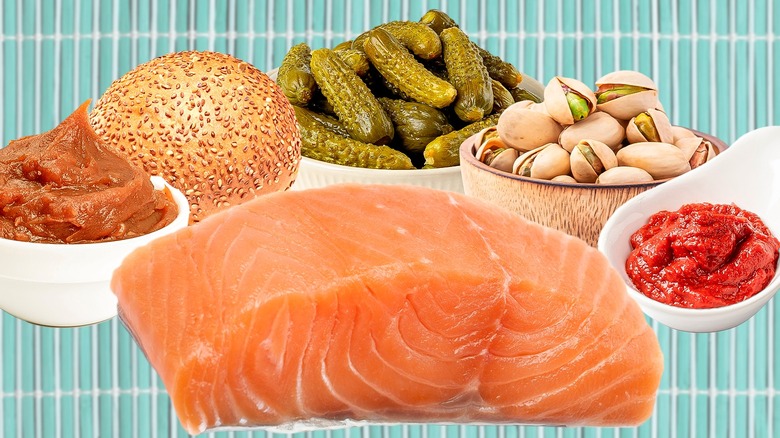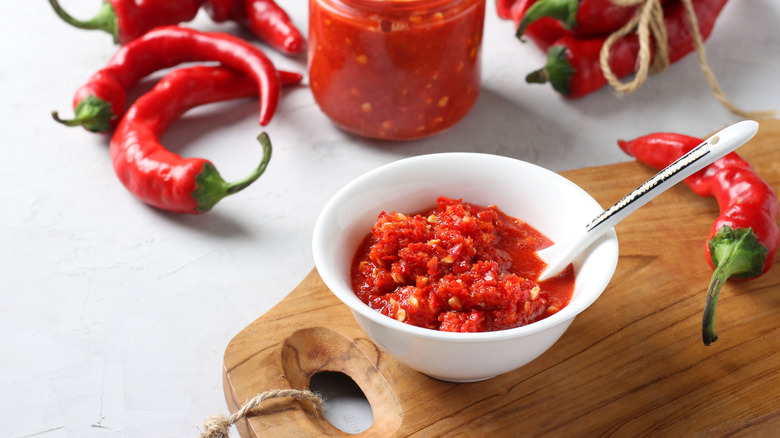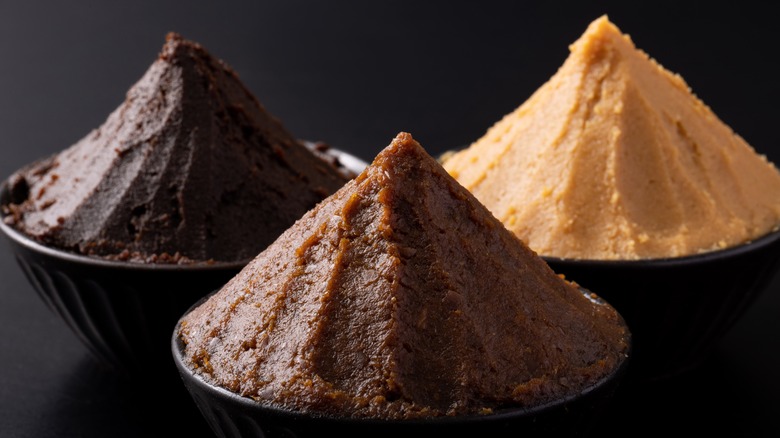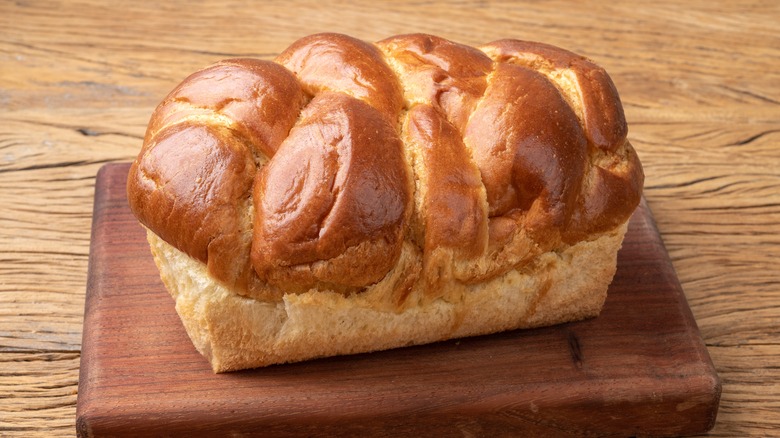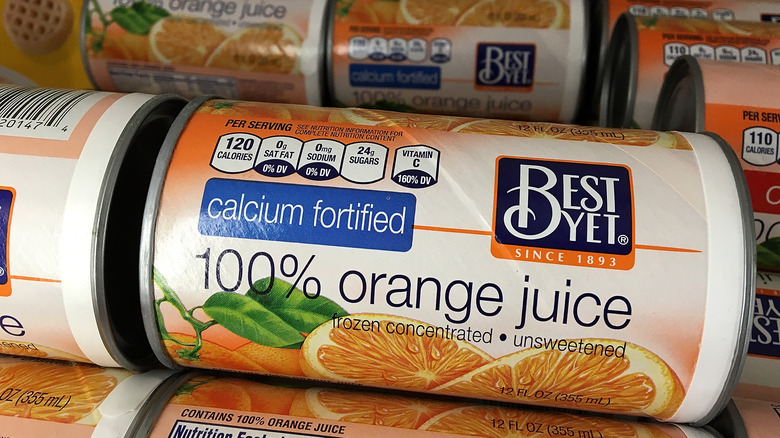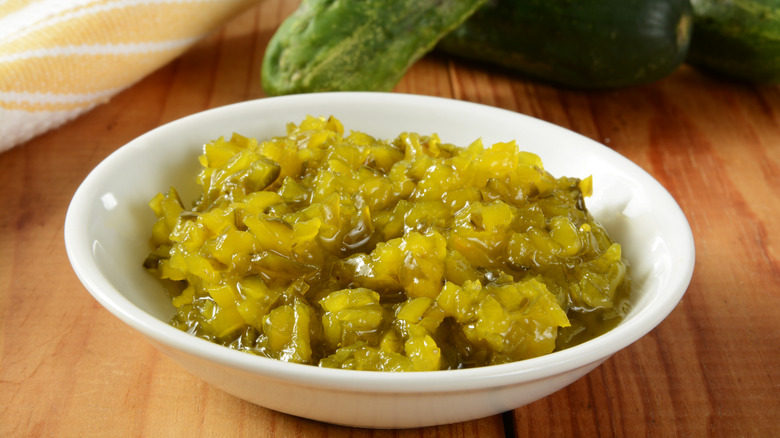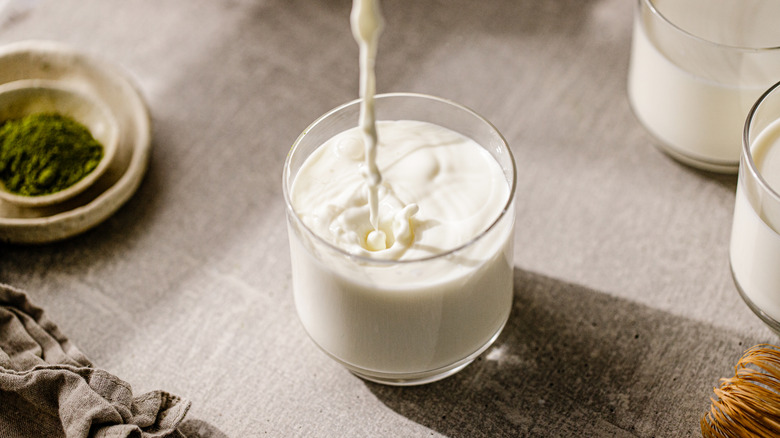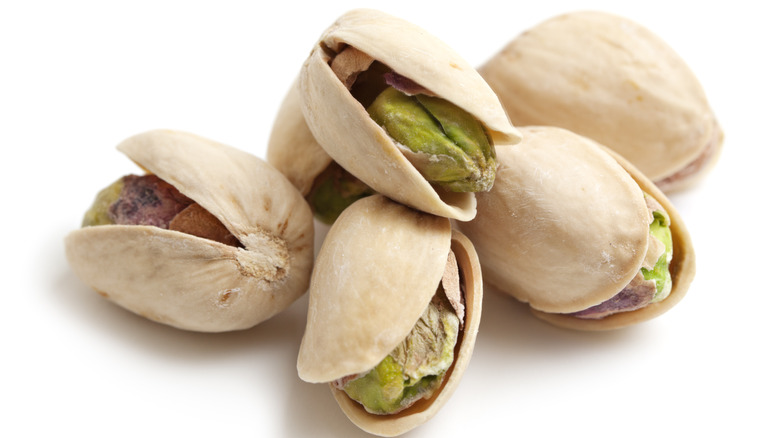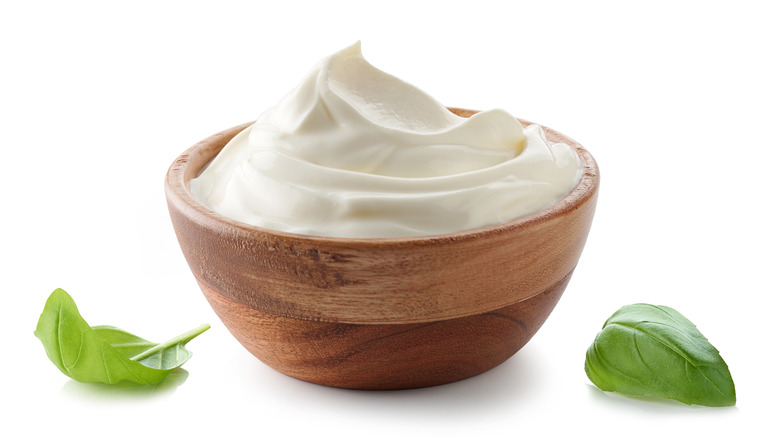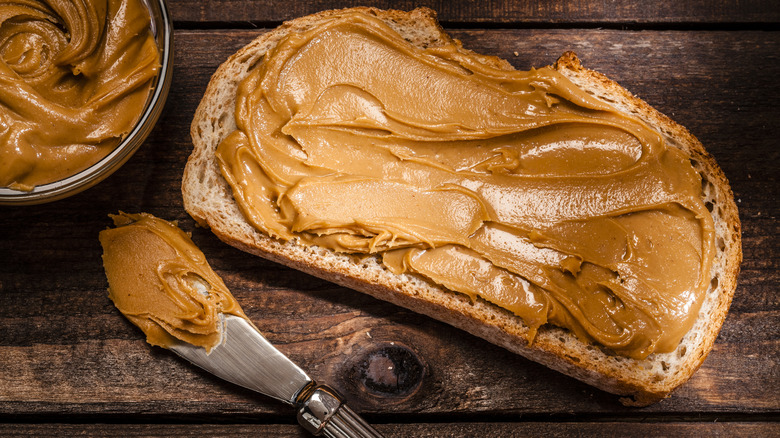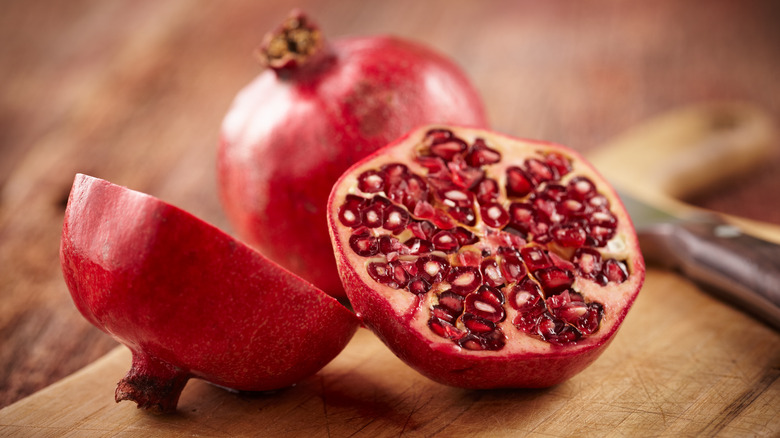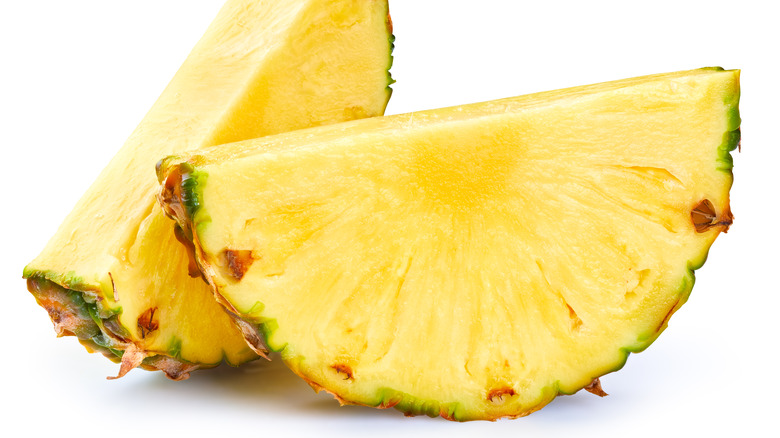12 Unexpected Ingredients That Pair Well With Salmon
Salmon may just be one of the most versatile fish in the sea (or river). It lends itself well to delicate, subtle flavors, but it's also robust enough to withstand strong, bright, and even spicy accompaniments. Whether grilled, baked, poached, smoked, or even enjoyed raw in sushi, salmon effortlessly adapts to an array of cooking methods, catering to diverse tastes and preferences. As you may have noticed, when gently poached, salmon remains tender and flaky, allowing its natural flavors to shine through. But when seared, its crispy skin and caramelized edges provide a satisfying contrast to the buttery flesh beneath. Not to mention, salmon also tastes great raw or cured, such as sushi, sashimi, or smoked salmon. In short, it's hard to ruin this fish.
Salmon's inherent versatility extends to its compatibility with a myriad of seasonings, marinades, and sauces, ranging from zesty citrus glazes to herb-infused butters. Many items that pair well with salmon are well known: lemon, capers, and dill are some of the most popular items. But there's a whole other world of ingredients out there that few people have thought to use on salmon but which work exceedingly well. Let's take a look at some of these surprising elements.
Harissa
The beauty of Harissa is that it can make your salmon taste great in less than 20 minutes. And don't worry about the fact that Harissa can be a bit spicy. Your salmon is strong enough in flavor and texture to support this level of spice and then some. This paste, typically made with a combination of garlic, coriander, dried chiles, and caraway seeds, can pack a lot of flavor into a tiny little jar, so there's no need to use more than a ⅛ cup of it for one salmon filet.
To make Harissa and salmon work for you, try our harissa baked salmon recipe. Top your salmon filets with salt, olive oil, and harissa paste, then simply bake the fish in the oven at 350 F for 14 minutes and not a second longer. Overcooking the salmon won't do you any favors, and in fact, it will probably dry it out and ruin your dish. Because you want the harissa to stand out here, don't serve this dish with anything too complicated. A simple salad and some plain rice or couscous will do.
Miso
Suppose the salmon's own natural umami isn't enough for you. In that case, it's possible to add more of this unique flavor by topping the fish with a mixture made with miso paste — which is essentially fermented soybeans with a lot of salt — rice vinegar, soy sauce, brown sugar, and red pepper flakes, if spiciness is what you desire. Once this concoction is ready, brush it onto your salmon filets and let them marinate for more than 30 minutes, after which it's time to bake them at 375 F for about 15 minutes. Making a miso salmon is just that easy.
The beauty of the miso salmon combination is that you can play around with texture and ingredients, and the result will be unfailingly good. Because now that you know about this secret combination, you may never eat salmon without miso again! One all-time favorite, for example, aside from the above recipe, is miso butter, which literally just requires those two ingredients: miso and butter. Simply blend them together and top your salmon filets with the mixture. Cook the salmon in the oven, grill it, or fry it in a pan. Whichever option you choose, the salmon will turn out full of deep, rich, umami flavor.
Brioche
If you already know that brioche is a type of bread, you might be wondering what in the world bread could have to do with salmon. It's not as if bread can melt into the dish, and simply eating it alongside the fish seems a little too simple. So what's going on here? The answer is that brioche crumbs make an excellent crust for salmon, giving it the perfect level of crunch –- not too soft and not too hard.
To prepare this recipe, start by putting the panko away and whipping out a brioche bun from your favorite bakery. Then bake the brioche chunks at 350 F for about 10 minutes, until golden. Then, zap them in a food processor with melted butter. Meanwhile, soak the salmon filets in brine for about 15 minutes, and when they're ready, top them with honey mustard, seasoning, and the brioche crumbs. Bake for 20 minutes at 350 F. Although this recipe can more easily be made with panko, since you can skip the food processor stage, it turns out heartier and more flavorful with better quality bread, such as freshly baked brioche. But equally, don't be afraid to experiment with other types of bread, so long as they're on the softer side. Challah, for example, might be just the ticket, especially if it's homemade!
Orange juice from concentrate
We all know about the joys of lemons and limes with salmon, but these are not the only citrus varieties that go well with this fish. Oranges can also be used to great effect, especially in the case of this idea, for maximizing the flavor of sauteed salmon. But don't just pour it on your salmon all alone. The trick, devised by Canadian chef James Barber, is to first add a pat of butter to your searing salmon before dropping a spoonful of frozen orange juice from concentrate onto your fish. This combination gives the fish a rich, sweet glaze.
Just ensure you don't substitute fresh orange juice for the concentrate variety, as they're different. Frozen, canned orange juice concentrate, which became popular after WWII, is a boiled-down version of orange juice that is much stronger in flavor and sweetness than the fresh thing. So, if you try using fresh orange juice in this recipe, you'll have a more diluted flavor and probably a bit too watery.
Bacon
Bacon goes well with everything, including chocolate, so it shouldn't come as a surprise that it can help complement a salmon dish. Even so, it's not that common to see bacon with salmon in restaurants or cookbooks, savory proteins bonding happily. But this marriage of the salmon's umami with the bacon's smokiness is not to be missed, so let's take a look at some of the best ways to put them together.
Because, as it turns out, salmon and bacon can be incorporated together in pretty much every meal. Toss crispy bacon and salmon flakes into your scrambled eggs, or use them as an omelet filling for breakfast. For lunch, wrap your salmon filet in thinly cut bacon and grill that baby until it's crunchy on the outside and soft in the middle. Add some garlic butter for good measure. And for dinner, go all out by throwing bacon into this smoked salmon pasta recipe. Just avoid adding a lot of salt to the pasta water, as there will be plenty to go around if you're using both smoked salmon and bacon. The key to making these dishes succeed and ensuring they don't overwhelm you with their richness is to serve them alongside something tangy, like the zesty cherry tomatoes in the pasta dish.
Pickle relish
Pickle relish is not an uncommon burger topping, but it's usually reserved for the good old-fashioned beef burger. But if you're a pickle lover, there's no reason why you can't branch out, and you'd be missing something big if you didn't also try pickle relish on a salmon burger.
To ensure the success of your venture and relish your relish, try making your own at home instead of buying the jarred stuff. All you have to do is zap some cucumbers in a food processor along with onions, salt, sugar, vinegar, mustard seeds, and celery seeds until everything is fully chopped up, but before the mixture becomes too mushy. At this point, you'll need to cook the relish for 10 minutes before straining it and refrigerating it for at least an hour. Once this very important step is complete, it's time to form and cook the salmon patties and top them with the relish and other accouterments of your choice. We recommend enjoying this on a brioche bun because everything is better with brioche.
Milk
Meat and dairy are thick as thieves, but fish and dairy are less obvious of a combination, especially when the dairy is not exactly visible in the final product. This seems to be the case with a trick Mashed reported will upgrade your fish recipes. The method, used by recipe developer Susan Olayinka, involves soaking your fish of choice in milk for 20 minutes before cooking it. This process helps remove some of that fishy smell while also tenderizing the flesh.
Once your fish has been thoroughly soaked, all you have to do is pat it dry, season it, and continue with your recipe as normal. The milk method works especially well with bigger, denser fish that need a bit of breaking in, like swordfish. So next time you prepare this swordfish steak recipe from Dining In, where the fish is cooked with butter, garlic, anchovies, and capers, soak the raw swordfish in milk first and see how much better your meal turns out.
Pistachios
It may seem strange to place a pile of nuts right on top of a salmon filet, but if they're combined with a glaze and properly pressed into place, they won't just roll off. Instead, they'll give your salmon dish the added flavor and crunch you never knew you needed from salmon.
Prepare this pistachio-crusted salmon by combining honey, Dijon mustard, salt, pepper, and fresh or dried thyme and rosemary. Pour this over the salmon –- it'll give your fish a delicious sweet flavor while also acting as the glue for the pistachio crust, which you'll make by chopping up shelled, salted pistachios and pressing them onto the glazed salmon. Bake for about 15 minutes at 425 F. If this sounds like a lot of work because of the whole pistachio shelling thing, don't worry; we have a cool trick to share with you. For those stubborn pistachio shells that just won't open, grab a discarded pistachio shell and use it to pry apart the sides of the recalcitrant nut. This way, you don't have to get your nails or teeth involved, thereby avoiding a potential injury as well as the ick factor of getting food under your nails again.
Yogurt
Yogurt, or variations thereof, is widely used in Middle Eastern, Mediterranean, and Central Asian cuisine, often providing a nice, soft tang to a spiced dish. But yogurt is far too often overlooked as an ingredient in American kitchens, and we think it's time for that to change. Enter the poached whole salmon with pistachio yogurt.
To make this recipe, you're going to need a fish kettle, as a whole salmon is typically a fairly large fish. Alternatively, you can cut up the salmon and poach it in separate, smaller pans, but this won't have the exact same effect as the real deal, plus the wow factor will be significantly diminished when it comes to presentation. Either way, start by placing your salmon in your chosen receptacle and filling the pot with enough cold water to cover the whole fish. Add bay leaves, fennel, lemon, peppercorns, and sea salt, and boil. Once the fish has cooled completely, remove the skin, cover it in cucumber slices, and serve it with plenty of yogurt sauce made with lime zest and ground pistachios.
Peanut butter
Peanut butter is probably the last ingredient you'd think would pair well with salmon, or any fish for that matter. And if it were about slathering some Skippy or Jif right onto the fish all on its own, you'd probably be right. But don't forget about Thai and other Southeast Asian cuisines, which often use satay sauce — a peanut-based sauce made with peanut butter, lime juice, soy sauce, garlic powder, honey, and chili flakes, among other ingredients — on things like chicken and beef. It's not too much of a stretch to think that salmon could be used in the place of one of these meats.
In fact, if you want to try this surprising combination, consider our satay-style chicken stir fry and just substitute the chicken with salmon. You can do this by combining the satay ingredients, along with coconut milk, chicken broth, and curry powder, if you prefer, stir-frying the salmon along with garlic and green onions, and pouring the sauce into the pan with the fish. Once the sauce has thickened, you'll have your salmon and peanut butter dish and be grateful for it, too. You can also try this recipe with any white fish strong enough to stand up to the depth and spice of satay sauce.
Pomegranate molasses
Pomegranate seeds can pack a pretty hefty flavor punch in those tiny little beads, but let's face it, cooking with them can be a little laborious. First of all, you have to somehow pry them out of their casing, seemingly one by one. Inevitably you will make a mess unless you use our special trick for removing pomegranate seeds. If you can manage this herculean step, you then have to deal with the little seeds rolling all over your dish unless you're using them in a salad where they can't help but stay put.
We have a solution to all this tinkering, including salmon. Next time you want to cook with pomegranate, go for the pomegranate molasses instead, which is fairly simple to make at home if you can't find it in stores. Procure some pomegranate juice and bring it to a boil in a pan with some salt. Reduce the juice until it becomes thick and syrupy; voila, you have your molasses. Once this is done, simply brush the molasses onto your salmon and fry, grill, or bake it. This is an excellent way to create a tangy, caramelized glaze.
Pineapple
Using pineapple for savory applications has long been controversial, largely because of pineapple's fame, or infamy, when it comes to Hawaiian pizza. But creating a tangy, not-too-sweet pineapple sauce, salsa, or chutney is nothing like the brute force, pineapple-in-your-face of the average Hawaiian pizza.
There are several ways of applying pineapple to salmon in a tasteful and sophisticated manner, and we're going to look at two of them here. A pineapple salsa is an ideal accompaniment to fish tacos, for example. This just requires you to combine diced pineapple with red onions, jalapeño, garlic, cilantro, lime zest, lime juice, and salt, and plop a dollop into your prepared salmon taco. You can also safely add this topping to cooked salmon. Another way to make this happen is with our Caribbean Jerk Alaska Salmon and Spiked Pineapple skewers recipe. For this one, you'll need to combine jerk seasoning with garlic, brown sugar, orange juice, soy sauce, and olive oil and marinate the salmon in this mixture. Then, it's time for the pineapple to make its grand entrance. Chop it up to a good skewer size and mix it into some brown sugar, chili powder, and allspice. Place the salmon and pineapple on skewers and grill or broil for just a few minutes on each side. Just be sure to drain the pineapple as much as possible before cooking it. Pineapple is extremely juicy, which is one of the things we love about it, but sometimes it gets in the way.
